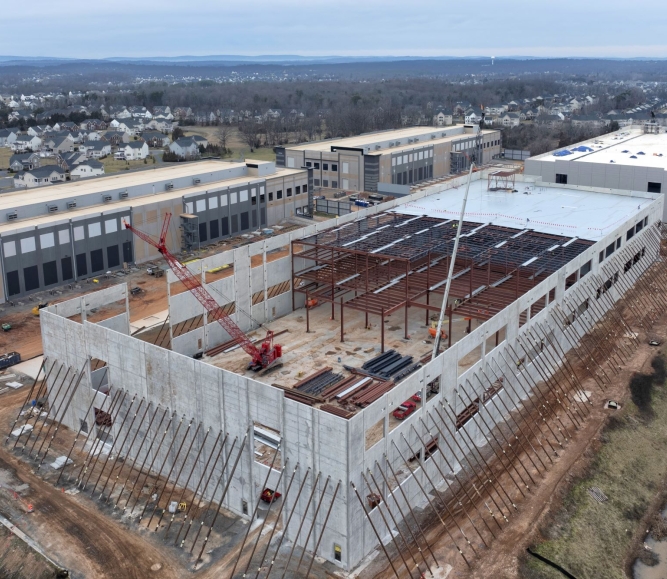Counties grapple with data center boom
Key Takeaways
As data center development continues to drive the U.S. economy, counties are tasked with determining whether the increased revenue data centers bring in is worth their drain on electricity and water and residents’ complaints of noise and rising utility bills.
This year, U.S. GDP growth has been almost entirely driven by investment in data centers and information processing technology; excluding data centers, the GDP growth was 0.1% in the first half of 2025, according to Jason Furman, a Harvard economist. And according to Renaissance Macro Research estimates, the dollar value contributed to GDP growth by artificial intelligence data-center buildout surpassed U.S. consumer spending for the first time ever in August.
Google’s Public Affairs Manager Broderick Green and Franklin County, Ohio Commissioner John O’Grady led a session on data centers Oct. 9 at the NACo Large Urban County Caucus (LUCC) symposium in Milwaukee County, Wis.
“If you haven’t looked into the data center development trend, start yesterday,” Green told the room of county officials, “because even if it doesn’t come to your community directly, I can assure you, one will be nearby. So, get up to speed on the latest technology, how they’re built, their resource management, their job numbers, community involvement.”
Data centers typically use the same amount of water each year as 1.5 to 3 golf courses, according to Green. In Northern Virginia, data centers consumed nearly 2 billion gallons of water in 2023 — a 63% increase from 2019 — with roughly 900 million gallons of water consumed in Loudoun County alone.
Virginia has the largest concentration of data centers in the world, and is home to 35% of all known hyperscale data centers, according to the Virginia Economic Development Partnership.
The average data center in Fairfax County uses more water than the average office building, but less than the average retail employer or hotel, according to Fairfax Water planning value analysis. To curb water waste, Fairfax County Supervisor Rodney Lusk said the county is looking to adopt the closed-loop cooling model that Loudoun County has found success with in many of its data centers.
A closed-loop cooling system recycles water, recirculating it to cool equipment. The system significantly reduces water consumption — by as much as 70%, according to the World Economic Forum.
In March, the Loudoun County Board of Supervisors approved amendments eliminating the previous “by-right” administrative approval process for data center development. Developers are now required to undergo a public hearing and review process by the Planning Commission and the Board of Supervisors, which includes proposing methods for reducing water consumption, such as implementing a closed-loop system.
Loudoun Water, the county’s water authority, also offers a reclaimed water program for industrial cooling that data center operators can connect to, to reduce their impact on the potable water supply.
It is key for counties to build relationships with their utility partners, because they are often the ones pitching tech companies to consider their areas for development, according to Green.
Google uses an approach it refers to as “climate conscious cooling,” meaning the company looks at each market it’s going into to determine the best cooling solution for it. “What might work best in Columbus, Ohio might be different than what’s done in Georgia,” said Green. “We don’t think there’s a one-size solution.”
The tech corporation is working to replenish 120% of the fresh water it uses in its data centers, and achieve net zero emissions, powering its data centers and campuses on carbon-free energy, by 2030, according to Green. The data centers Google is building now are six times more efficient using energy than data centers it was building just a few years ago, he noted.
“Data centers use a lot of power,” Green said. “There’s no use beating around the bush on that. And the newer ones — whether it’s AI or the more cutting-edge technologies — it’s a lot more power … We don’t want to stress infrastructure, and we spend a lot of time thinking about how we can operate better and more efficiently.”
In O’Grady’s home state of Ohio, American Electric Power has already committed to supplying electricity for 30 data centers in the region by 2030, meaning the area of Columbus (Franklin County’s seat) will reach power consumption levels as high as Manhattan’s. Factoring in tech industry proposals to develop 90 more data centers, Franklin County’s power consumption could be comparable to the entire state of New York during a peak summer day, as reported in August by The New York Times.
In Franklin County, “a lot of local folks were concerned that their bills are going to go up based on these data centers, as opposed to the data center paying for it,” O’Grady said. The Public Utilities Commission of Ohio determined that American Electric Power, the local utility company, could apply a different fee structure for data centers and other users, to ensure that tech companies are paying for the infrastructure upgrades needed for development, according to O’Grady.
In December 2024, a Virginia agency found that even though data centers have generally been paying their fair share of grid upgrade expenses, costs to residents could still rise $276 a year by 2030, because of data centers — and that cost could be substantially higher if construction plans for data centers are delayed, or if they’re never built or use less electricity than planned, the New York Times reported.
As environmental concerns and community backlash to data centers increase, local governments are cracking down and creating more regulations around development.
As of June, tech companies looking to build data centers in Henrico County, Va. will now have to attend a public hearing, allow the public to comment and get approval for a provisional use permit from the Board of Supervisors. Previously, companies only needed approval from the county’s Planning Commission to buy property and start building.
The Henrico County Board of Supervisors committed $60 million — tax revenue generated from Quality Technology Servies’ (QTS) data center in the county — toward an affordable housing trust fund. The developer is contributing an additional $5 million to a solar program for low income residents in Henrico County, according to Reverend Tyrone Nelson, a Henrico County supervisor.
“That was one of the things that kind of won us over, even though there were some environmental concerns, use of water and energy and even noise, and all the things that come with this conversation now,” Nelson said. “We also looked at the fact that we were in a housing crisis, and we feel like we still are, and anything that we could do to make housing more affordable, that was important to us.”
There has not been a data center project approved in the county since the new regulations went into effect earlier this year.
“Personally, I just don’t want them all over my district,” Nelson said. “… If it was up to me, we wouldn’t approve any more.”
During the construction phase, the average data center employs 1,688 local workers and provides them $77.7 million in wages, according to the U.S. Chamber of Commerce.
While data centers don’t employ many people after they’re up and running, they’re high-paying jobs — an electrician can make up to $150,000 to $200,000 a year, O’Grady noted.
Fairfax County is looking at training opportunities for its lower-income residents through its Workforce, Innovation, Skills Hub to “prepare them for the jobs of the future,” particularly at data centers, Lusk said.
“Because as we grow more of these facilities, you’re going to need talent to be able to equip them and build them out,” Lusk said. “… The money that’s generated to the county and to the cities and others is really based on that refresh of the technology over time, as well.
“You’ve got some people working, but that’s not where the lion’s share of the tax base and the revenues are coming from,” he noted.
“And the good thing is, we see with quantum computing and AI, it’s growing so fast, so there’s not a need for less data centers.”
Data centers aren’t going anywhere or slowing down development any time soon, so it’s up to counties to determine which projects are the right fit for their community, Green said.
Counties should be leveraging data centers to improve their communities, not hinder them, so local officials need to be asking themselves whether a given project is supporting their local economy, schools, constituents and “all of the things that make your communities great,” he noted.
“There’re some bad projects out there, and sometimes the deal you don’t do ends up being the best thing, based on the evaluation for your community,” Green said.
“So, wherever you are in a given moment of time, use that as your anchor point when you make this decision, because sometimes it can feel like that freight train is coming and you’re on the tracks and can’t get out of the way and there’s nothing you can do about it, but you absolutely can.
“You have every right to,” he said.
“And then run the numbers. At the end of the day, it’s a business decision for both parties.”
Related News

County Countdown – Dec. 1, 2025
Every other week, NACo's County Countdown reviews top federal policy advocacy items with an eye towards counties and the intergovernmental partnership.

Counties Celebrate Key Permitting Inclusions in SPEED Act
NACo issued the following statement in response to the passage of the Standardizing Permitting and Expediting Economic Development (SPEED) Act (H.R. 4776), which advanced out of the U.S. House Committee on Natural Resources on November 20.

House Natural Resources Committee advances Standardizing Permitting and Expediting Economic Development (SPEED) Act
On November 20, the U.S. House Committee on Natural Resources advanced the Standardizing Permitting and Expediting Economic Development (SPEED) Act (H.R. 4776), which would make important changes to streamline federal permitting and strengthen county involvement in decision-making by amending the National Environmental Policy Act. Counties support commonsense permitting reforms, and NACo secured provisions in the SPEED Act that would guarantee counties a seat at the table during federal environmental reviews.
County News
Counties try to keep data center development in bounds
Once a cash cow, data center development is becoming a more delicate planning issue for counties, particularly as AI use drives demand.

